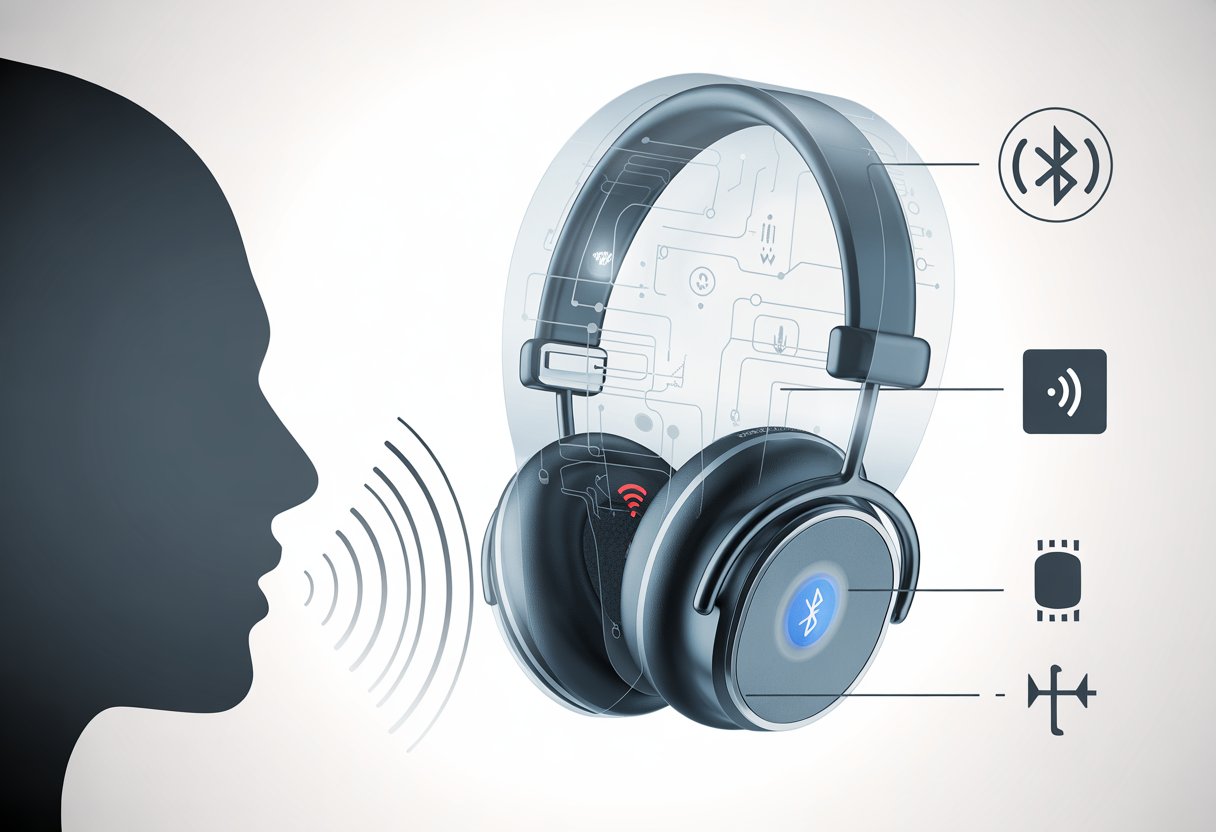Ever tried telling your Bluetooth headphones to do something, only to get total silence in return? You’re definitely not the only one.
Usually, Bluetooth headphones don’t pick up voice commands because the microphone isn’t set up right, or maybe the device’s voice control settings need a bit of tinkering. Sometimes, it feels like the headphones just don’t care—kind of like a cat when you call its name at dinner.

Honestly, it’s a bit embarrassing to shout “Play music!” into thin air and get nothing back. It makes you wonder if you’re talking to a robot or just losing it.
But don’t stress—there are some straightforward reasons for this, and better yet, things you can try to fix it.
Ready to stop feeling ghosted by your own headphones? Let’s dig into why Bluetooth headphones sometimes act like they’re on vacation, and what you can do to get your voice commands working again.
Maybe, just maybe, they’ll listen the first time.
Understanding How Bluetooth Headphones Handle Voice Commands
Getting Bluetooth headphones to listen to voice commands sometimes feels more like casting a spell than using tech. Everything depends on how they connect, how their microphones work, and what the headphones are built to do.
Bluetooth Connection Basics
First, let’s talk about how Bluetooth makes headphones work with your devices. When you pair them, the headphones use different modes—one for just listening (stereo or high quality), and another for talking (headset mode).
Here’s the catch: using the mic usually flips you into headset mode. Sound quality drops, but now you can shout, “Call Mom!” instead of typing.
Connecting is usually smooth, but not every device handles sound and mic activity perfectly. Ever noticed your music quality drops or voice commands just don’t work? That’s the Bluetooth protocols and limited bandwidth messing things up.
If your headphones show up twice in the device list—once as headphones and once as a headset—that’s not a glitch, it’s just how Bluetooth splits things up. For the tech curious, there are some good examples of Bluetooth headsets causing audio or voice problems.
Key Components: Microphones and Voice Guidance
Now, let’s get into microphones. Some headphones come with fancy beamforming mics, while others just have tiny pinholes doing their best. If your mic isn’t picking up your voice, voice commands won’t work—simple as that.
A lot of times, we think we’re talking to our phones, but it’s actually the headphones’ mic that’s listening. A glitch, a blocked mic, or even a gust of wind can send your command into the void.
Sometimes, voice systems don’t kick in because communication between the headset and phone gets delayed. This happens a lot, especially when you try a command for the first time on a new device.
There are some useful tips about voice commands not working on Bose headsets. So, if your headphones ignore you, it’s probably not personal—they’re just not catching what you’re saying.
Common Reasons Why Voice Commands Aren’t Working
Bluetooth headphones are supposed to make life easier—when they actually work. If they stop picking up your voice, it’s usually down to device settings, stubborn apps, or just too much noise in the background.
Device Is Not Set as Default Audio Device
Sometimes, our devices just refuse to cooperate. If your Bluetooth headphones aren’t set as the default audio device, you can shout “Hey Google” all day, but your phone might send the sound somewhere else.
To fix this, open the settings menu on your phone or computer. Go to the audio or sound section.
You should see a list of available output and input devices. Pick your Bluetooth headphones for both playback and recording.
Try this quick checklist:
- Go to Settings > Sound
- Set your headphones as default for both output and input
- Test with a simple command like “What’s the weather?”
If you skip this, your voice commands never reach your headphones, and your device just shrugs.
App Settings May Be Holding You Hostage
Sometimes, the problem isn’t your headphones or your device. It’s the app itself.
A lot of apps have their own audio or Bluetooth settings buried deep in menus. Check in-app settings, especially if voice commands work elsewhere but not with one app.
Some apps want you to enable Bluetooth permissions or pick your Bluetooth headphones as the mic. This pops up in assistant apps, music players, or smart home apps.
If you’re on Android, uninstalling recent updates to the Google app sometimes fixes voice commands not available issues. Always check for app updates—sometimes fixes just sneak in.
Ambient Noise Confusion
We like to think our headphones are smart, but a busy coffee shop or loud street can totally throw them off. Too much ambient noise confuses the mic and makes it tough for your device to understand you.
Your headphones have to sort your voice from all the chaos. Give them a break—try voice commands in quiet spots or move closer to the mic.
Some headphones have noise cancellation, but even the fanciest ones have limits. Loud background noise can still ruin your “Play my favorite song” request.
If your headphones are struggling, it’s probably just the crowd—not you.
Troubleshooting Bluetooth Headphones for Voice Command Issues
It’s so annoying to shout “Hey Google” or “Hey Siri,” only to have your headphones play dead. Usually, a moody microphone, sketchy Bluetooth connection, or that dramatic speak-to-chat feature is to blame.
Checking Microphone Sensitivity
Let’s start with the microphone. If microphones could sigh, yours probably would when you yell from across the room.
Sensitivity matters—a lot. Make sure the mic isn’t set so low it ignores you, or so high it picks up every random sound.
Many headphones let you adjust microphone sensitivity, either in their app or in your device’s settings. Increase the sensitivity if your voice sounds faint, but don’t crank it up too much—otherwise, every cough or sneeze will set it off.
Try a voice memo app or recorder as a test. If your voice sounds quiet or far away, tweak the mic sensitivity.
Sometimes, a firmware update helps fix microphone bugs. And don’t forget, dust or lint can block the mic, so give it a gentle clean now and then.
Reconnecting the Bluetooth Link
Bluetooth can be as unpredictable as the weather. Sometimes your headphones just decide to have “connection issues” at the worst moments.
If the mic’s not working, try disconnecting and reconnecting the headphones. First, turn Bluetooth off and back on from your phone or laptop.
Remove (or “forget”) the headphones from your device, then pair them again like it’s day one. This often clears up glitches that block the mic.
If you’re still stuck, maybe a bad firmware update or device setting is to blame. Double check that your headphones connect in headset mode, not just for music—otherwise, the mic won’t work.
Sometimes, it helps to check with the manufacturer’s support, like Google Assistant issues on headphones, for advice that fits your model.
Stuck in a Speak-to-Chat Loop
Ever started talking to someone in real life, and your headphones randomly mute music or turn on voice commands? Welcome to the weird world of speak-to-chat.
This feature tries to help, but often just gets in the way. When it’s on, speak-to-chat listens for your voice, pauses your music, and waits for a command.
Sometimes, it just won’t turn off or gets stuck, endlessly muting or activating features you never asked for. The best fix is to disable speak-to-chat in the headphones app or device settings.
If that doesn’t work, try toggling it on and off. Some brands even suggest restarting speak-to-chat by talking to your digital assistant, or reenabling and disabling Siri, as mentioned in this thread about voice control issues.
If you’re still trapped in the loop, check the user manual or look up online guides. Someone out there has probably figured it out.
Speak-to-Chat and Automatic Audio Detection Features
Bluetooth headphones are clever, but sometimes their “smart” features just make things more confusing. One big reason voice commands don’t work? Speak-to-Chat or automatic audio detection settings can get in the way.
How Automatic Audio Detection Works
Automatic audio detection sounds fancy, but really, it just means your headphones are always listening for your voice—sometimes a bit too much.
When this is on, the headphones try to figure out if you’re talking or just humming. The goal? Pause or lower the volume when you start speaking.
It’s great for ordering coffee without yelling, but here’s the problem—if you cough, sneeze, or sing along, the headphones might think you’re talking to them.
Some headphones, like Sony’s, only run Speak-to-Chat if automatic audio detection is enabled. If you suddenly find yourself in silence after a sneeze, blame Speak-to-Chat for catching your “achoo.”
You can check more about how this works on the Sony Help Guide.
Accidentally Enabling Speak-to-Chat
We’ve all pressed a button or tapped something in the app and accidentally turned on Speak-to-Chat. Suddenly, every accidental hum or muttered complaint pauses your podcast.
Turning off Speak-to-Chat isn’t always as simple as you’d hope. Sometimes, you’ll need to dig through the app, find the right setting, and switch it off.
If the sensitivity’s too high, headphones might still get confused by background noise. Lowering detection sensitivity can help, but it’s not a perfect fix.
For really stubborn headphones, use the official app to adjust or turn off Speak-to-Chat completely. You can pick up tips from other headphone owners dealing with the same thing on this Reddit thread about Speak-to-Chat.
Headphone Controls: Mastering Touch Panels and Buttons
Using Bluetooth headphones isn’t just about putting them on and hoping for the best. You really need to know how the touch and button controls work, or you’ll end up pausing every Taylor Swift song by mistake.
Touch Sensor Control Panel Tricks
Touch panels on headphones can feel like a tiny invisible piano—one that only listens when it feels like it. If your headphones act more stubborn than a cat in a bath, check that your fingers are clean and dry first. Oily or wet fingers? The panel might ignore you like a moody teenager.
Common gestures? Try these:
- Double-tap to play or pause.
- Swipe up or down for volume.
- Hold for voice assistant.
If the touch panel refuses to cooperate, check if “wear detection” is off. Sometimes, headphones decide you’re not wearing them and just shut off the controls. You can fix this in your headphone app, as this Reddit discussion on touch control fixes points out.
Wipe the sensor area, too. Pocket lint, crumbs, or some mysterious sticky stuff (we’re not judging) can mess with the touch panel.
Manual Reset Techniques
If every tap and swipe gets ignored, it’s time for the classic reset. Most headphones have a manual reset button combo—usually pressing and holding the power and volume buttons together until the LEDs blink like a disco ball.
Check your instruction manual or, even better, the official Sony reset guide for the exact steps. Once you reset, you’ll need to re-pair your headphones with your devices.
Resetting feels like starting over, but it often kicks out those sneaky glitches. If nothing works, try searching for a good instruction video. Sometimes, seeing the steps makes all the difference.
Device and Platform-Specific Obstacles
Bluetooth headphones love to keep us guessing. Some devices and platforms just don’t get along with voice commands. You end up shouting at your headphones, hoping they’ll finally listen.
Google Voice Command Compatibility
Bluetooth headphones and Google Assistant? Not always best friends. Only certain microphones—usually the ones built for calls—work smoothly for voice assistants. It’s like playing charades with your gadgets and hoping they guess “Hey Google!”
Features built into your headphones, plus the manufacturer’s app, decide if Google voice commands work. Some headphones need a special button for Google Assistant, while others ignore you completely. If your headset focuses on music, it might not care about “OK Google” at all.
Problems also show up if you’re using the wrong settings or your phone’s Bluetooth permissions are off. Make sure the audio input device is set to your headphones in your phone’s settings. If your phone uses its own mic instead, Google hears nothing but muffled pocket noises.
Windows 10 Audio Drama
Windows 10 brings its own brand of chaos to Bluetooth and voice commands. You connect your headphones, and suddenly either the mic or the headphones give up. It’s that classic “it’s not you, it’s me” routine, but with software.
When you try using your headset’s mic, Windows 10 might treat it as a low-quality “Hands-Free AG Audio” device. That means muffled sound and lost voice commands. Switching to high-quality “Stereo” fixes the audio, but then the mic goes silent.
Set your headphones as the default device in Windows 10’s sound settings. Disconnect extra Bluetooth devices—this community tip can help. Sometimes, unplugging and reconnecting is the magic move. Honestly, “turn it off and on again” is still a classic.
Additional Causes and Unusual Suspects
Sometimes Bluetooth headphones just do their own thing. Here are a couple of odd reasons your voice commands might fail, even when everything looks fine.
Music Playback Interruptions
You’re jamming to a song, and it pauses or stutters when you try a voice command. This isn’t just headphone drama—Bluetooth connections can only handle so much.
When you activate the mic, most Bluetooth headphones switch to “headset mode.” That mode sends lower quality audio so the mic can work. This trade-off often drops music quality or silences your tunes while the headset listens for your command.
Some headsets just stop the music entirely, making you restart playback. If your favorite song keeps ghosting you when you use voice commands, check which mode your device uses (media or headset). This helpful thread dives deeper into why this happens.
Noise Cancelling May Be Too Good
Noise cancelling feels like a superpower, but sometimes it’s too much of a good thing. Instead of just blocking out chaos, it might block your own voice from reaching the mic.
If your headphones have strong noise cancelling, the microphones might focus on noise instead of commands. They could mistake your polite “Hey Google” for background chatter and ignore you. It’s like your headphones are saying, “Shhh, I’m relaxing.”
Some headphones use multiple mics. If one gets too obsessed with filtering out the barking dog next door, it might miss your command entirely. Try lowering noise cancelling or turn it off if you want better responsiveness. Outwitting headphones is trickier than it should be.
Getting Help: Support, Warranty, and Accessories
Sometimes, Bluetooth headphones just don’t listen—literally. When that happens, you need help without going on a wild goose chase. Good support, warranty info, and the right gear (plus tracking that order you definitely placed) can really make things easier.
Product Support and Warranty Information
Let’s be honest: sometimes you just need backup when your headphones ignore you. Most brands offer online help guides with steps to reset, pair, and troubleshoot. You can usually find answers, like how to reset your headphones and restore factory settings, which wipes out glitches and forgets every device it’s ever met.
Warranty is your safety net. Check if your headphones are still covered. Brands ask for receipts, serial numbers, and sometimes proof you actually own headphones. If you’re under warranty, repairs or replacements are usually free. Out of warranty? You’ll probably pay, but at least you’re not stuck.
If online steps don’t fix things, most support pages have chat bots, real people, or both. Ask, “Why won’t my voice commands work?” and sometimes you’ll get more than just, “Try turning it off and on again.” But let’s be real—sometimes that actually works.
Ordering Speaker Accessories
We all lose stuff. Ear tips vanish, headbands break, and chargers go missing. Most brands let you order replacements from their official site. Having your model number handy saves you from ordering a part that only fits your neighbor’s headphones.
Accessory shopping should be easy. Look up the part, check the price, and toss it in your cart. Some brands even sell cool extras—ear cushions in wild colors or carrying cases that actually close. Buy original parts if you can—they fit right and usually last longer than those “almost right” off-brand bits.
And here’s a tip: watch the shipping costs. Sometimes that tiny part costs less than the postage. Might as well stock up on everything you think you’ll lose next time.
Order Tracking for the Truly Lost
Order tracking is where hope and reality collide. We all want to know where our lost headphones—or maybe just their missing parts—ended up.
Most earbud-makers fire off a tracking number as soon as they ship your order. Then, we get to watch the package crawl across the map, moving at the speed of, well, a turtle on vacation.
If you never see that confirmation email, don’t panic. Support staff can usually dig it up for you.
A lot of sites let you track your order just by logging in or punching in your order number. Keep your order info close, because nobody wants to admit they only remember buying “those Bluetooth things.”
Sometimes, packages take the scenic route. Some support hotlines will actually reach out to the delivery company for you.
It never hurts to ask—your stuff might be hanging out at the post office, just waiting for its big reunion.
- Best Bluetooth Headphones for Side Sleepers: Snooze in Stereo Without the Sore Ears - December 2, 2025
- Best Fitness Trackers for Kids Who Move Faster Than Your Wi-Fi - December 1, 2025
- How to use Bluetooth headphones with gym equipment without looking like a techno-ninja - December 1, 2025






